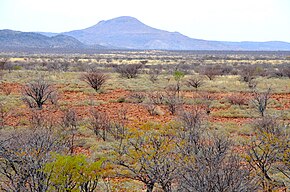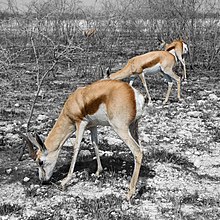Veld (/vɛlt/ or /fɛlt/), also spelled veldt, is a type of wide open rural landscape in Southern Africa. Particularly, it is a flat area covered in grass or low scrub, especially in the countries of South Africa, Lesotho, Eswatini, Zimbabwe and Botswana. A certain sub-tropical woodland ecoregion of Southern Africa has been officially defined as the Bushveld by the World Wide Fund for Nature.[1] Trees are not abundant—frost, fire and grazing animals allow grass to grow, but prevent the build-up of dense foliage.



Etymology
editThe word veld (Afrikaans pronunciation: [fɛlt]) comes from the Afrikaans word for "field".
The etymological origin is older modern Dutch veldt, a spelling that the Dutch abandoned in favour of veld during the 19th century,[2] decades before the first Afrikaans dictionary.[3][4] A cognate to the English field, it was spelt velt[5] in Middle Dutch and felt[6] in Old Dutch.
Climate
editThe climate of the veld is highly variable, but its general pattern is mild winters from May to September and hot or very hot summers from November to March, with moderate or considerable variations in daily temperatures and abundant sunshine. Precipitation mostly occurs in the summer months in the form of high-energy thunderstorms.
Over most of the South African Highveld, the average annual rainfall is between 500–900 millimetres (20–35 in) a year, decreasing to about 250 millimetres (9.8 in) near the western border and increasing to nearly 1,000 millimetres (39 in) in some parts of the Lesotho Highlands; the South African Lowveld generally receives more precipitation than the Highveld. Temperature is closely related to elevation. In general, the mean July (winter) temperatures range between 7 °C (45 °F) in the Lesotho Highlands and 16 °C (61 °F) in the Lowveld. January (summer) temperatures range between 18 °C (64 °F) and 30 °C (86 °F).
In Zimbabwe the precipitation averages around 750–900 millimetres (30–35 in) on the Highveld, dropping to less than 350 millimetres (14 in) in the lowest areas of the Lowveld. Temperatures are slightly higher than in South Africa.
Over the entire veld, seasonal and annual average rainfall variations of up to 40 percent are common. Damaging drought affects at least half the area about once every three or four years; it reduces plant and animal biomass to sustainable levels again. Everywhere the average number of hours of annual sunshine varies from 60 to 80 percent of the total amount possible.
Definitions
editHighveld and Lowveld
editHighveld
editMuch of the interior of Southern Africa consists of a high plateau, the higher portions 1,500–2,100 m (4,900–6,900 ft) of which are known as the Highveld, starting at the Drakensberg escarpment, 220 km (140 miles) to the east of Johannesburg and sloping gradually downwards to the west and southwest, as well as to the north, through the Bushveld towards the Limpopo river.[7] These higher, cooler areas (generally more than 1,500 metres or 4,900 feet above sea level) are characterised by flat or gently undulating terrain, vast grasslands and a modified tropical or subtropical climate. To the east, the Highveld's border is marked by the Great Escarpment, or the Mpumalanga Drakensberg. Still, the boundary is often arbitrary and not apparent in the other directions. The blesbok and quagga were among the large animals that once roamed on the highveld in great numbers. Nowadays, there still is a sizeable population of springbok in some areas,[8]. However, much of the area is devoted to Balls farming and South Africa's largest conurbation (Gauteng Province).
Lowveld
editThe lowlands, below about 500 m (1,640 ft) altitude, along South Africa's northern border with Botswana and Zimbabwe, where a 180-million-year-old failed rift valley cuts into Southern Africa's central plateau and locally obliterates the Great Escarpment,[9][10] is known as the Lowveld.[11] The Limpopo and Save rivers run from the central African highlands via the Lowveld into the Indian Ocean to the east. The Limpopo Lowveld extends southwards, east of the Drakensberg escarpment through Mpumalanga Province and ultimately into eastern Eswatini. This southern limb of the Lowveld is bounded by South Africa's border with Mozambique to the east and the northeastern part of Drakensberg to the west.[12] This region is generally hotter and less intensely cultivated than the Highveld. Until the mid-20th century, the Lowveld was still infested by the tsetse fly which transmits the sleeping sickness called nagana among the Zulus.[13]
Thornveld
editThornveld (also thorn veld or thornveldt), often referred to as "acacia thornveld", is a type of semi-arid savanna in which grassland with thorny acacia and certain species of thorny bushes predominate. The predominant plant species are usually different in the thornveld of the plains or in the hill thornveld, where, for example, species of genus Balanites are common.[14] Some of the characteristic species[15] in the thornveld include:
- Grasses: Grass species belonging to genus Themeda and Hyparrhenia
- Trees and bushes: Genus Acacia and Rhus, such as Acacia afra, Acacia sieberiana and Rhus pentheri and other species like Ziziphus mucronata, Ehretia rigida and Cussonia spicata.
Sandveld and Hardveld
editSandveld
editSandveld, in the general sense of the word, is a type of veld characterised by dry, sandy soil, typical of certain areas of the Southern African region. It usually absorbs all water from the seasonal rains, although aquatic habitats, largely seasonal, may be also found in specific places in the sandveld.[16] Only certain hardy plant species thrive in the sandveld environment. These consist especially of grasses forming clumps and certain kinds of trees and shrubs.[17] The sandveld vegetation has a particular pattern of growth, rarely covering the whole terrain and thus leaving patches of sandy soil exposed on the surface. Some of the typical sandveld species are Acacia haematoxylon, A. luederitzii, Boscia albitrunca, Terminalia sericea, Lonchocarpus nelsii, Bauhinia petersiana and Baphia massaiensis.
Hardveld
editHardveld is a term applied to certain rocky soil areas in Botswana, mostly in the eastern part of the country. The landscape is an undulating plain with scattered rocky hill ranges. There are areas of hardveld also in South Africa in the mountainous central Kamiesberg of the Northern Cape with hilly escarpments and deep river valleys. The soil of the hardveld is characterised by rocky outcrops, as well as an abundance of stones and pebbles of different shapes and sizes.
The flora of the hardveld is typical of rocky savanna, with denser vegetation and thus less denuded patches than in the sandveld, as well as taller trees.[18] There is also a higher diversity of species in the hardveld compared with the sandveld. Peltophorum africanum, Acacia nigrescens, A. tortilis, Combretum apiculatum and Colophospermum mopane are some of the representative species of the northern hardveld.[19]
See also
editReferences
edit- ^ "Southern Africa bushveld". Terrestrial Ecoregions. World Wildlife Fund.
- ^ Winkel, Lammert Allard te. De grondbeginselen der Nederlandsche spelling: Regelen der spelling voor het Woordenboek der Nederlandsche Taal. Publisher: D. Noothoven van Goor, 1873. Download from: [1]
- ^ Eric Anderson Walker (ed). The Cambridge History of the British Empire, Volume 4. Cambridge University Press 1963 (Afrikaans: pp. 890–894)
- ^ Berger, Iris. South Africa in World History. Oxford University Press, 2009. ISBN 978-0195337938
- ^ Lemma = "velt", Middelnederlandsch Woordenboek, Dutch Language Union
- ^ Lemma = "felt", Oudnederlands Woordenboek, Dutch Language Union
- ^ Atlas of Southern Africa. (1984). p. 13. Reader's Digest Association, Cape Town
- ^ Richard Despard Estes, The Behavior Guide to African Mammals, University of California Press, ISBN 978-0-520-27297-2
- ^ McCarthy t. & Rubidge B. (2005) The Story of Earth & Life. p. 246-247. Struik Publishers, Cape Town.
- ^ McCarthy, T.S. (2013) The Okavango delta and its place in the geomorphological evolution of southern Africa. South African Journal of Geology 116: 1-54.
- ^ Atlas of Southern Africa. (1984). pp. 13, 192, 195. Reader's Digest Association, Cape Town
- ^ Atlas of Southern Africa. (1984). pp. 13, 182, 192. Reader's Digest Association, Cape Town
- ^ Steverding, Dietmar (2008). "The history of African trypanosomiasis". Parasites & Vectors. 1 (1): 3. doi:10.1186/1756-3305-1-3. ISSN 1756-3305. PMC 2270819. PMID 18275594.
- ^ "Thorn Veld Ecozone – Kruger National Park". Ecotravel.co.za. Archived from the original on 11 May 2012. Retrieved 31 October 2012.
- ^ "KwaZulu-Natal Department of Agriculture – Mixed Thornveld Ecozone". Agriculture.kzntl.gov.za. Archived from the original on 1 July 2012. Retrieved 31 October 2012.
- ^ "Aquatic Ecosystems of the Sandveld-Saldanha" (PDF). Archived from the original (PDF) on 20 July 2011. Retrieved 31 October 2012.
- ^ "Thamnochortus bachmannii". PlantZAfrica.com. Retrieved 31 October 2012.
- ^ "Microsoft Word – ORIG_Basin Profile.doc" (PDF). Retrieved 31 October 2012.[permanent dead link]
- ^ "FAO Country Pasture/Forage Resource Profiles – Botswana". Fao.org. Archived from the original on 15 September 2012. Retrieved 31 October 2012.
External links
edit- Jacobs, Nancy (2000). "Grasslands and Thickets: Bush Encroachment and Herding in the Kalahari Thornveld". Environment and History. 6 (3): 289–316. doi:10.3197/096734000129342316. JSTOR 20723144.
- The Veldt, Ray Bradbury (1950)